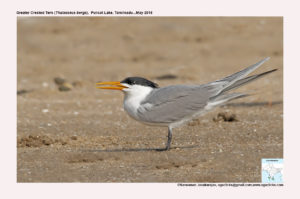Greater-crested Tern

Greater-crested Tern Thalasseus bergii
Etymology:
- Thalasseus : Greek word for Fisherman derived from thalassa – sea
- Bergii : Named after German collector H. Bergius (1790–1817)
Vernacular Names : Guj: Chotili dariai dhomdi, Motili dariyayi vabagali, Ta: Periya kondai aala, Sinh: Muhudu lihiniya, Mald: Gardooni, Lakshadweep: Tharathassi, Hindi: Badi Kalgidar Tehari, Mar: Motha Turewala Suray
Distribution in India: Widespread winter visitor except North, North West and parts of East India.
Description: Size of 43–53 cm; Wt. of 320–400 g; wingspan of 100–130 cm. It is a large tern with white forehead in breeding plumage, with has a glossy black cap and long crest; neck, underparts and secondaries are white, latter contrasting with otherwise grey back and upperwing. The bill is chrome-yellow, sometimes tinged greenish at base, or entirely greenish yellow with irregular black blotches; feet are black. The non-breeding adult has white crown with some dark spotting, but retains black on hindcrown. The juvenile has crown feathers tipped brownish, upperparts and upperwing very heavily mottled or barred brown, primaries are dark brown with white on inner webs, secondaries are ashy brown with white tips; bill is greenish; feet is brownish black. The immature resembles non-breeding adult, but has browner crown with pale spots, and brown markings on neck, back and wing-coverts.
Habitat: It is found in tropical and subtropical coasts and oceanic islands.
Food habits: It eats fish, squid, crabs, insects, baby turtles and other aquatic prey. It engages in piracy, but more often a victim. It forages in shallow waters of lagoons and barrier reefs, in estuaries, along beaches, and also well out to sea. It rests on buoys or on rocks and sandbars, often with other terns and gulls.
Breeding habits:They breed in Apr–Jun in Indian Ocean, May–Jun in Sudan and S Africa, Aug in Somalia, Oct in Kenya, Nov in Tanzania, Sept–Dec in E Australia, and Dec–Jan in tropical Australia. The nest is a shallow scrape in bare sand, rock or coral.They lay a clutch of 1-2 eggs. The incubation period is 25–30 days. The fledging period is 38–40 days. The chicks leave the nest in two days but are dependent at least until four months.